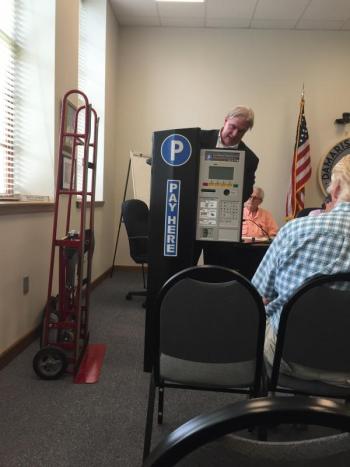‘Parking should be friendly, not free’
Damariscotta had a look at its potential future Wednesday, July 29.
Although nothing has yet been decided, the board of selectmen, along with business owners and town officials, met with Brett Ruhmann, regional sales manager for Cale America on Wednesday, July 29 to discuss some of the possibilities for pay-for-parking.
Town Manager Matt Lutkus said the Wednesday meeting, which featured Ruhmann showing an example of a pay-for-parking meter, did not mean the town was getting ready to implement seasonal pay-for-parking.
“This isn't a policy meeting — we're not here today to discuss if we want pay-for-parking or not,” Lutkus said. “In Mid-September we will have a meeting with the Twin Villages Alliance to discuss policy. Today we are just here to discuss the technologies that are available.”
The town has recently started discussing the potential revenue that could be generated if it were to add pay-for-parking in the large municipal parking lot that looks out over the harbor.
During its May 20 meeting, the board brought up the possibility of considering pay-for-parking in the municipal lot. The money that would be raised from the paid parking would then be used to rebuild the lot.
Damariscotta has been considering paid parking since May 2013, when it used an ASK grant to fund a study by the University of Southern Maine.
That report found that despite business push-back, the paid-for parking plan would increase the town's revenues.
One of the issues raised by the USM report was that a paid lot would likely increase the number of cars on Main Street, as drivers would likely seek free parking.
One of the upsides, as related in the USM report and by Ruhmann, was that the paid parking could increase the amount of turnover in the lot, as people would be less likely to stay for the full three hours if they were being charged for it.
“You can even adjust it so (the allowable hours) are shorter during the day to increase turnover then make it longer at 5, 6 p.m. when people are coming to the restaurants,” he said. “There's a lot of flexibility.”
After the initial plan was floated the town hosted an open house in 2013. During that meeting several business owners and residents voiced their displeasure with the idea of adding a paid lot. One of the complaints at that meeting was that motorists and tourists would decide to drive to other coastal towns instead of paying for parking.
Shortly afterward, the pay-for-parking plan was shelved and the waterfront committee was formed to come up with ideas. One of the ideas was to raise funds like the town was able to do for Skidompha Library.
Since the open house, the price tag for the project has increased. Just restructuring the lot to fix drainage and pipe deficiencies and to enhance its flood resiliency is expected to cost in the neighborhood of $1 million. From there, other proposals have included making the boardwalk resemble the Herald, which is one of the town's famous ships from its boat building days, complete with public bathrooms and pedestrian walkways.
The lot will need to be rebuilt, however, as sink holes and large puddles have started forming in recent years. Like most of downtown Damariscotta, the lot is also in a high-risk flooding zone, which will eventually affect the downtown business owners' insurance rates.
Ruhmann said the Cale system is found along the Maine coast in places like Old Orchard Beach, Saco, Portland, and potentially Wells Beach. It is also currently used in Hampton Beach, Portsmouth and Durham, New Hampshire.
One of the issues Ruhmann stressed was safety; if the parking is tracked via license plate, the town will know who is coming into the town. But, Damariscotta Police Chief Ron Young said the parking enforcement officers already know, as they record the license plate of every car in violation.
Young said he was against getting rid of human eyes in the parking lot.
“If you're looking to replace parking (enforcement officers), you can't,” he said.
Ruhmann said other towns have used “parking ambassadors” to greet people when they come into the lot.
“Parking should be friendly, not free,” he said.
Ruhmann said the parking meters would cost between $7,000 to $7,200 without cash capability and $9,000 to $9,200 with the ability to take paper money.
“(Paper money) is the number one service issue we get called for,” he said. “Nowadays, 70 to 80 percent of transactions are done with a debit or credit card.”
Another issue raised was what to do with the locals. Since the first open house meeting about the parking lots, it was agreed that if the town was going to implement a pay-for-parking structure, then Damariscotta residents and potentially taxpayers should be allowed free or reduced-price parking.
One suggestion floated Wednesday was to give people a card they could swipe at the machines or a sticker to put on their windshield when they register their cars. One issue raised at the Wednesday meeting was what to do when a Damariscotta resident exceeds the three-hour limit.
Event Date
Address
United States
























